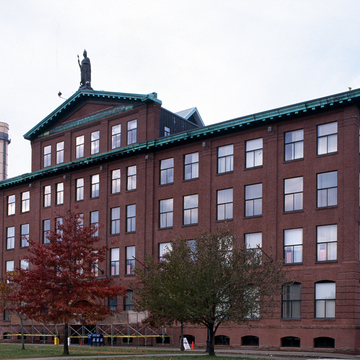The Broad Canal (1805 established, 1806 plans, Peter Tufts for the Cambridgeport Proprietors) and related canals represented a new era of industrial development in East Cambridge. Substantial industrial construction did not begin in this area until the late nineteenth century, when railroads, not water, provided transportation. The surviving canal maintains the original eighty-foot width but has been reduced to approximately one thousand feet long.
Located near the Charles River end of the canal are three buildings that document the former importance of this industrial zone. In 1895, Lockwood, Greene and Co., designed the Athenaeum (later Cuneo) Press Building (1923 expanded, 215 1st Street, NR) for Ginn and Company. A statue of Athena surmounts the entrance pavilion, and finely detailed brickwork conceals the standard mill construction within. Between the Athenaeum Press building and the Broad Canal stand Carter's Ink (239 1st Street), the work of Densmore and Le Clear (1910; 1983 remodeled, Priestly, Sterling). An important early example of reinforced concrete industrial construction, Carter's Ink still retains allusions to classical architecture with its exterior cast-concrete pilasters. Immediately adjacent to the canal rises the Cambridge Electric Light Company plant (265 1st Street), a late Moderne exercise with streamlined windows by Gilbert and Associates from 1947–1949. An


